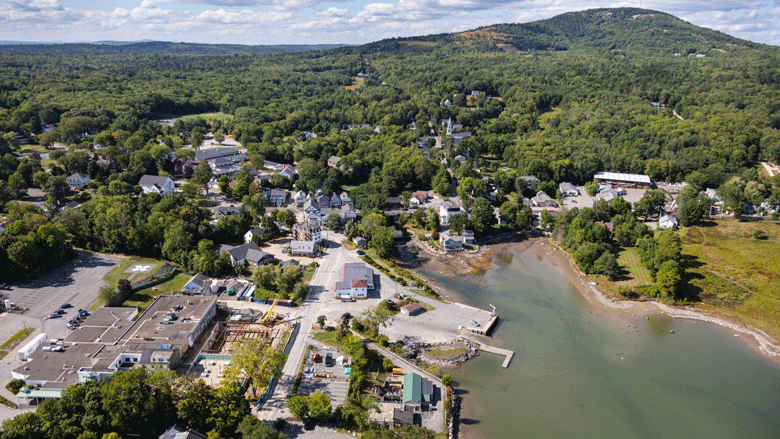A task force in Blue Hill is developing strategies to mitigate the impact of sea level rise on the town’s infrastructure and other resources. And it’s determined that the greatest risk is to the town’s wastewater treatment facility.
“It will be an expensive task to upgrade the current facility as well as to plan for a final disposition no later than the end of the century,” according to the task force’s 2020 report.
The task force is recommending that Blue Hill prepare for sea levels to rise 3 feet by 2050 and 8.8 feet by 2100. The situation impacts not only Blue Hill residents, but those of all nine towns on the Blue Hill peninsula.
Other infrastructure likely to be impacted by sea level rise, storm surges, and flooding included the local fire department, town wharf, cemetery, town park…
“I would say the towns have an interest in being prepared and dealing with an issue before it becomes a real problem,” said Allen Kratz, convener of Peninsula Tomorrow, an ad hoc group that includes Blue Hill, Brooklin, Brooksville, Castine, Deer Isle, Penobscot, Sedgwick, Stonington, and Surry and tackles a variety of issues the towns have in common. Kratz credited the Island Institute as instrumental in getting the coalition started.
While the plant directly serves Blue Hill, there would be an impact to all nine towns if it were to shut down. That’s because Blue Hill is a regional service hub that includes a hospital, pharmacies, supermarkets, building supply stores, and other retailers and service providers—essentially, community lifelines—used by residents of surrounding towns and would be affected by problems with the treatment plant.
Kratz helped coordinate support for a successful Infrastructure Adaptation Fund grant of $1 million, along with a request for an earmark for another $1 million federal grant pending before the Congressional appropriations committee.
“People come from Stonington to Blue Hill for medical care,” Kratz said by way of example. “The hospital has next to it a suite of medical offices, so it’s not just the hospital. It’s physicians and specialists. That’s why we were able to generate letters of support even though they’re not served by the plant directly.”
The plant dates back to 1975.
“After nearly a half century of wear-and-tear from the waters of the Blue Hill Harbor, Blue Hill’s wastewater treatment facility is in need of upgrades and repairs to improve reliability for families and businesses in the area,” Rep. Jared Golden said in a press release. Golden noted the additional $1 million in federal funds would go toward repairs to the plant and upgrades that prevent further degradation from the rising water levels.
The Infrastructure Adaptation Fund grant was awarded by the Maine Department of Transportation. The $1 million was part of a total of $19.9 million awarded to 13 communities across Maine for municipal investments to protect vital infrastructure from effects of climate change such as flooding, rising sea levels, and extreme storms.
Statewide, recipients will use the funds for projects to address flooding along ocean and riverfronts, protect stormwater and wastewater systems, install culverts to reduce flooding, and ensure energy availability during extreme storms.
“The effects of climate change present significant challenges for our vulnerable infrastructure,” DOT Commissioner Bruce Van Note said in a press release.
Most recently, the town was also approved for U.S. Department of Agriculture grant of $1.25 million and a loan for $2.75 million, with a 2.65 percent interest rate over 28 years, said Blue Hill Administrator Nicholas Nadeau.
The situation is growing urgent, he said.
“The sea level is rising, making it difficult for the current equipment to treat and pump out the treated material,” Nadeau said. “Additionally, the equipment is outdated and on the smaller side for capacity compared to other municipalities with comparable size and influent.”
According to the task force, the wastewater treatment facility, at 48 Water St., is one of Blue Hill’s most vulnerable assets. It’s located less than one foot above the highest annual tide and has experienced trouble with outflow as pressure builds during high tides, necessitating the use of temporary measures.
“Rising sea levels and storm surge events have the potential to cause increasing harm,” the task force said.
The task force was convened in 2020 specifically to study the potential impacts of sea level rise, storm surges, and increased freshwater runoff from major rainstorm events on the town’s infrastructure, and to recommend adaptive strategies, a prioritization schedule, potential funding sources, and professional assistance.
In addition to the wastewater treatment plan, the task force determined that other infrastructure likely to be impacted by sea level rise, storm surges, and flooding included the local fire department, town wharf, cemetery, town park, and a variety of state and town roads.
Due to their low-lying locations, the fire station and town landing, like the treatment plant, have already experienced flooding as a result of high tides and storm surge events.
Northern Light Blue Hill Hospital and the Blue Hill Fire Department, both located near the waters of Mount Desert Narrows, cited a flood that was caused by an unusually high tide, which caused the outflow of a culvert, located behind the hospital, to back up.
Other areas, such as a cemetery and park, are on shoreline bluffs of soft gravel and dirt and are considered susceptible to sea level rise and storm surge.
The task force identified potential strategies to mitigate the situation, including the placement of rip rap, a living shoreline, sea walls, breakwaters, and a lock—a dam-like structure that controls the amount of sea level allowed into a harbor.
Other coastal communities winning funding:
- Bath—$4 million
- Berwick—$1.425 million
- Boothbay Harbor—$4.15 million
- Eastport—$165,750
- Kennebunkport—$2.585 million
- Ogunquit—$2.85 million
- Rockland —$75,000
- Scarborough—$60,000





